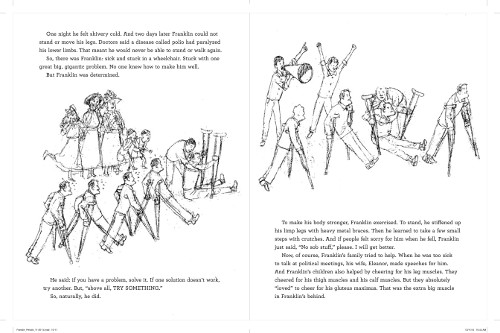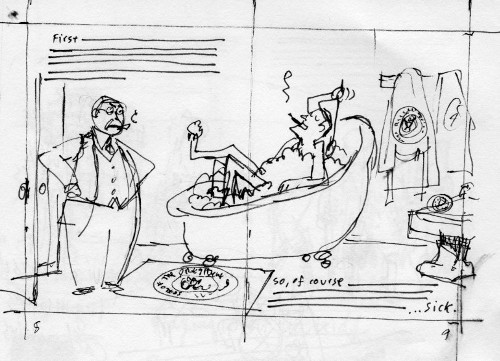A Visit with Larry Day
 March 22nd, 2016 by jules
March 22nd, 2016 by jules
exactly like his famous, older cousin, President Ted.”
(Click to enlarge spread)
Illustrator Larry Day is in 7-Imp Land today to talk about creating the artwork for Suzanne Tripp Jurmain’s new picture book (Dial, January 2016), Nice Work, Franklin!. The book—which kicks off the story of Franklin D. Roosevelt’s presidency by emphasizing how much he idolized his cousin, President Theodore Roosevelt—is a lively account of FDR’s challenges and successes as President. Jurmain brings readers an accessible text filled with engaging anecdotes about FDR’s life.
Larry, who has illustrated many books about American history, talks here today about the artwork, what a Wolff pencil is, and why he likes illustrating nonfiction in general.
Enjoy!
Jules: What was your first response to Suzanne’s manuscript?
Larry: When I first read the manuscript, I was immediately transported back to one summer afternoon in 1975. I had just returned home to my mid-western farm community from college. I was finally 19, old enough to walk into the local tavern to order a brew. I felt all grown-up.
It was just me and the bartender. Out of the blue, he asked who my three favorite presidents were. I listed George Washington, Abraham Lincoln, and John F. Kennedy. He said, “My favorite three presidents are FDR.” He said FDR pulled the country out of the worst depression in history and got the country back on its feet. He told me about all the programs that FDR had started, that FDR put people back to work and gave everyone hope for the future. He quoted FDR’s famous line, “The only thing we have to fear is fear itself.”
Later that afternoon, at the kitchen table with my mother, we discussed a fresh new topic: politics. I asked who her favorite president was. She also named FDR — and for the very same reasons. She added how he helped farmers get loans for their crops, started Social Security, and protected our money by establishing the FDIC.
That afternoon made such a lasting impression on me! When I got the manuscript, I knew I had to illustrate this book.

I then draw the final drawing, using my preliminary drawing only as a guide.
I then draw directly onto the watercolor paper and finish it from there.”
(Click to enlarge)

That gave me more room for the text.”
(Click to enlarge)

(Click to enlarge spread)
Jules: What is it, in particular, about nonfiction texts you love to illustrate?
Larry: With non-fiction texts, I love to illustrate different eras’ culture, clothing, and characters’ interactions, all in a convincing manner.
Early in my career, a spark was ignited for me when I illustrated a series for the Chicago Tribune Sunday Magazine on books by influential Chicago authors. These were scenes from Studs Lonigan (James Farrell), Native Son (Richard Wright), and The Jungle (Upton Sinclair). Even though the entire Tribune series was on books of fiction, I had to illustrate different periods in history and make them believable and compelling. This project showed me how much I truly connect with recreating the drama of stories in history.


The Franklin D. Roosevelt Presidential Library and Museum.”
(Click to enlarge final drawing)

put banks back in business. …”
(Click to enlarge spread)
Jules: Tell me about your research for Nice Work, Franklin!
Larry: There is so much written and photographed on FDR, which is a great thing, but it can be overwhelming. In addition to reading about FDR, I spent a lot of time researching photographs and documents in the Franklin D. Roosevelt Presidential Library and Museum. I’m most grateful for the help of the staff and the director of the library, Robert Clark. As in most collections, I found many unique photos that were not available in the vast online libraries. These were very helpful, especially the images of breadlines and the WPA and CCC programs that FDR and his cabinet set up across the nation. I also had help from Jim Mills, archivist at St. Thomas’ Parish in D.C., who had a rare photograph of the parish where FDR attended service before heading to his inaugurations. This photograph was so valuable, as this parish was burned down by an arsonist in the 1970s. (It was since rebuilt, but it looks very different now.)
Jules: The Kirkus review notes how you found “opportunities for lightness” (such as Franklin in the bath, pictured at the top of this post). Did you purposely look for those?

I discovered that the tub would have been a flatter style,
reflecting a more modern design at the time.”
(Click to enlarge sketch)
Larry: Yes, finding the lightness is very much on purpose. I wanted to make Roosevelt come alive and, to me, using humor livens up the story, in addition to helping a young reader take in the heavier parts. I spend a lot of time working on the best way to heighten scenes with levity and was careful with the placement of these moments in the book. I pushed some scenes toward the ridiculous: FDR in the bathtub scrubbing his back, a 237-pound shark in the back seat of Franklin’s car. (No, I didn’t find photo reference for this!) And a grocery store owner, in full-stride beside Franklin’s car, handing FDR a cooked turkey on a plate.


(Click to enlarge spread)
I did a lot of research on the exact car FDR would have been riding in at the time and the Presidential seal on the side of the door. As you can see from my preliminary drawing [above], I moved the people away from the side of the car so we can see FDR and Eleanor and the seal.
With Nice Work, Franklin!, there were parts in the text that were sobering: like men in a breadline or FDR in church, being escorted by Eleanor to his inauguration. But when it was appropriate, I found ways to lighten up even serious scenes. For example, where FDR is speaking into a flotilla of microphones during a fireside chat, I thought it would be funny to show a woman pounding on the radio to get him to stop talking. (Some folks would have wanted to get back to their regular radio programs, and I wanted to show that.)

(Click to enlarge)

(Click to enlarge final drawing)

(Click to enlarge spread)
Jules: I see you did this in Wolff pencil. For non-artists like me, what’s that?
Larry: Wolff pencils are made with carbon. They have a boldness and darkness to the line quality with less smearing than charcoal. I even use Wolff pencils to draw thumbnail sketches. I can use water to add tone. Wolff pencils were a pencil of choice used by early illustrators, like Henry Raleigh and F.R. Gruger. They were also commonly used by architects.

(Click to enlarge)
Jules: What’s next on your plate? Working on anything now you’re allowed to talk about?
Larry: Raisin, The Littlest Cow is in the proof stages. It’s by Miriam Busch, our second for Balzer + Bray, set to be released March 2017. I’m working on The Underground Railroad, a third book with Kay Winters in her Voices series. In addition, I have several other projects at different stages: a wordless book and a non-fiction graphic novel. All that, while continually drawing storyboards for TV commercials and sleeping on occasion.


(Click to enlarge final drawing)

popping up in a coal mine.”
(Click to enlarge spread)
Jules: Anything else you want to share?
Larry: I don’t remember much history from school. And if it was taught, it floated right through my ear and out the window. I wasn’t much of a listener. And I was never much of a reader, either — back then, I poured all my energy into drawing. One of my hopes is that when reluctant kid readers (like me) open up one of my books, they’ll be captivated and compelled to continue learning about history.
NICE WORK, FRANKLIN! Copyright © 2016 by Suzanne Tripp Jurmain. Illustrations copyright © 2016 by Larry Day. Published by Dial Books for Young Readers, New York. All sketches and art here used by permission of Larry Day.



A delightful and insightful interview. I was fascinated by Larry’s creative process and felt I had visited this piece of American history through significant players.
Beautiful job from Mr. Day, as always. Larry can draw large crowds of people in his sleep…a nightmare for most of us.
Nice work, Larry.
We all envy Larry’s draftsmanship. He seems to see things we mortal artists overlook and somehow translates those observations into lively,original, compelling drawings. It’s a lovely book from a great artist.
Loved seeing the journey of this book. Larry Day has a way of keeping the child-like fun in this historical setting. The spread with the construction projects and an outdoor circus complete with tightrope walkers is genius!